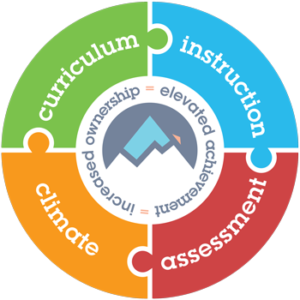Share this article.
We are told that teachers should develop students that can evaluate their own learning. The thinking is that this will make them active participants in their own education and guide them towards becoming lifelong learners. We at Elevated Achievement Group wholeheartedly agree. However, we wonder, “Why doesn’t the educational system place equal, if not more, emphasis on teachers being evaluators of their own practice?”
The Critical Lever for Instructional Excellence
Researcher John Hattie tells us that the most effective teachers are the most reflective teachers. He feels that teachers who think about their practice, reflect on the impact of their practice, and evaluate their practice in terms of student understanding are the most effective at getting students to learn. In fact, he says, “Such passion for evaluating impact is the single most critical lever for instructional excellence—accompanied by understanding this impact and doing something in light of the evidence and understanding.”
Self-evaluation has a positive impact on teaching and learning for students. What we now need is a culture that promotes self-evaluation on teaching and learning as a support for teachers. A culture that doesn’t just value self-evaluation but develops and demands it. How can a school support such a culture? There are three main steps in the process of developing reflective and effective self-evaluators.
Step 1: Determine Your Components for Reflection
 First, the school must determine which components directly affect student learning. These should be what each teacher will reflect upon in order to self-evaluate. What are the most impactful student supports that teachers should strive towards in every lesson? These supports need to be researched-based, clearly defined and achievable by all. These supports also must be directly controlled by the teacher and should fall into the areas of curriculum, instruction, assessment, and climate and culture of the classroom. These supports will ensure that:
First, the school must determine which components directly affect student learning. These should be what each teacher will reflect upon in order to self-evaluate. What are the most impactful student supports that teachers should strive towards in every lesson? These supports need to be researched-based, clearly defined and achievable by all. These supports also must be directly controlled by the teacher and should fall into the areas of curriculum, instruction, assessment, and climate and culture of the classroom. These supports will ensure that:
- All student learning is driven by a standards-based curriculum with measurable and achievable outcomes.
- All student learning is driven by highly engaging, effective, and efficient instruction.
- All student learning is driven by regular assessment that guides instructional decision making.
- All student learning is driven by a positive academic climate.
Everyone on site must agree with each support indicator and clarify why each support indicator is important to student achievement.
Step 2: Identify Your Strengths and Gaps
Once there is an aligned understanding of these support indicators the second step begins. During this step each teacher starts the practice of identifying his or her strengths and gaps. This is a where self-reflection truly begins as individual teachers measure themselves against the agreed upon support indicators. Teachers must think about each support indicator and answer the questions, “How well do I guarantee my students are provided with these supports?” and “Are there areas that I could improve on and what do I need to make that improvement?”
Step 3: Define Your Action Plan
Finally, there needs to be an action plan. As educators develop and refine their teaching, grounded in the most impactful practices, and as they develop a process for continuous self-evaluation of their growth, they need to have a well-defined action plan. This plan should include the desired outcome and the process for achieving the outcome. The plan must be steeped in opportunities for self-evaluation as well as support and feedback from others. Basically each teacher must answer the question, “What will I do in order to ensure these student supports are continually in place when I deliver instruction?”
A Final Note — Don’t Do It Alone
Although self-evaluation implies an individual practice, this is a process that requires and deserves support from the collective school community. This support includes providing opportunities for teachers to implement practices specific to their identified areas of growth. It includes an environment that promotes risk-taking, collaboration, and time for guided reflection. And it includes exemplar models of practice and of self-evaluation to develop the mindful habit of continual self-reflection and improvement.
We strive to develop students that can evaluate their own learning and become lifelong learners. Don’t we want to demand the same for our teachers? Don’t we want to demand a system that allows all teachers to be active participants in and control more of their own learning? Shouldn’t we have a system that allows all teachers to receive the support needed to be lifelong learners? We believe we not only should, we must.
Continue the Learning
Check out these articles and resources to continue your learning about this topic…
The Learning Brief
In this article you learned…
- Teachers who reflect daily on their practice are the most effective at increasing student learning.
- A culture of self-reflection can be built.
- Three steps to support reflection include: 1) Determining the components that will be reflected upon and how they support student achievement, 2) Identifying strengths and areas of growth, and 3) Developing an action plan to build on strengths and fill in gaps.
Can you imagine building an environment full of motivated, engaged, and eager students who own their learning?
We can.


